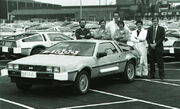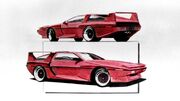 | |
| Native name | АО «МК „Делорян“» |
|---|---|
| Romanized name | AO "MK 'Deloryan'" |
| Type | Joint-stock company |
| Traded as | RFB: MKD |
| Industry | Automotive |
| Founded | October 24, 1975 |
| Founder(s) | Ivan Deloryan |
| Headquarters | Alekseyevka, Alaska |
| Area served | Worldwide |
| Key People | Maria Myakelya (Chairwoman and CEO) Yekaterina Deloryan (President) |
| Divisions | Deloryan Kalikov Yo-Mobile |
| Subsidiaries | Transportation Kiruda Moskvitch Trabant International Deloryan Africa Deloryan Europe Deloryan Mexico Deloryan Russia Deloryan USA |
| Website | deloryan.com |
JSC Deloryan (Russian: АО «Делорян», AO "Deloryan"), officially known as the JSC Deloryan Motor Company (АО «Моторная компания „Делорян“», AO "Motornaya kompaniya 'Deloryan'"), is an Alaskan multinational automotive manufacturing company headquartered in Alekseyevka, Alaska. It was founded by Ivan Deloryan on October 24, 1975. The company produces and sells a range of vehicles under the Deloryan, Kalikov, and Yo-Mobile brands. The company also holds a controlling stake in Kiruda (Manchuria), Trabant (Prussia), and Moskvitch (Russia).
History
Prior to the company's founding in 1975, Vladikaskady native Ivan Zakharovich Deloryan had already made a name for himself within the Alaskan automotive industry. His career began in 1953 where he worked for Gulyaka. In 1956, he accepted a leading role in Shashka (a subsidiary of General Motors). Deloryan's leadership at Shashka is often credited for the expansion of Alaska's automotive sector and setting the trends of the modern car culture. Continued hostilities between Deloryan and Detroit would result in him leaving GM-Shashka in 1973.
On October 24, 1975, the Deloryan Motor Company was founded and originally headquartered in Vladikaskady. The early investment capital came primarily from business loans, partnerships, and private investments from select parties (such as Pyotr Kalikov and various Alaskan personalities). Deloryan also sought incentives from various organizations and governments in order to pay for the company's first manufacturing facility. Due to his name recognition and notoriety, a joint offer was made by New Caledonia and the Alaskan federal government as part of a broader effort to revitalize the governorate. The Moskovsky administration was also pressured to help rejuvenate the declining Alaskan automotive industry following the 1973 Oil Crisis.

The 1,000th De-12 made.
In October 1978, construction began on the 660,000 square futs manufacturing facility in the vicinity of Alekseyevka. The new workforce would come from across Alaska, Asia, and the rest of North America. The first vehicle to be produced at the plant was the Deloryan De-12 sports car in late 1979. Despite early setbacks and mechanical issues related to the first batch of vehicles, the De-12's unique appearance and the subsequent "Live the Dream" («Живи мечтой», "Zhivi mechtoy") marketing campaign, the company would see early success and optimism.
The second vehicle manufactured was the Deloryan De-24 compact sedan, released in 1982. During the same year, the Deloryan Motor Company went public and began to be traded on the Ross Stock Exchange, bringing in more money for further development. In late 1983, the Deloryan De-100 was released and became the first modern minivan to debut in North America (beating out Chrysler and Renault by months). In 1985, a second manufacturing facility was completed in Pokatello, Oregon. This new facility would strictly specialize in buses, snowcats, and trucks. The first vehicle produced at this facility was the Deloryan De-44, an all-wheel drive utility vehicle which was to compete in the growing pickup truck and sport utility vehicle markets of North America.

Second Generation De-12.
In July 1985, the film Back to the Future premiers. In the film, a Deloryan De-12 is converted into a time machine. The film's global success would further boost the brand's notoriety and would result in more sales. Also in 1985 (yet unrelated to the film), Deloryan unveiled the second generation De-12. Along with a slight facelift, the next gen sports car was to include a higher preforming engine, a reduced weight for faster speeds, and new cost-saving materials which would reduce the price of future Deloryans.
During the late-1980s, Deloryan would begin their international expansion. New factories were opened in Brazil, Mexico, South Africa, and the United States. In 1988, agreements were made with both Bulgaria and the Soviet Union to provide knock-down kits for their plants in Lovech (which had previously been manufacturing Moskvitches) and Maotsdzedun in the Manchu SSR (MaoAZ). In 1992, Deloryan purchases a controlling stake in the Prussian automaker Sachsenring and announced a plan to revitalize the communist-era Trabant marque to compete with Škoda and Talbot in the European markets.
Beginning in 1986, two new plants were constructed in Spring Hill, Tennessee, and in Mexico. In 1988, agreements are made with both Bulgaria and the Soviet Union to provide knock-down kits for their plants in Lovech (which had previously manufactured Moskvitches) and Maotsdzedun (headquarters of MaoAZ). In 1992, Deloryan purchased a controlling stake in in Prussia and announcing the intention of modernizing the communist-era Trabant marque for the European market.
In 1993, Deloryan acquired the trademarks and licensing from Pyotr Kalikov on his former ventures into creating a car company in the 1970s. The Kalikov division was established and would focus on luxury and performance vehicles, and would release an updated Mirage. Due to the collapse of the Soviet Union in 1991, Deloryan began new efforts to expand into both the Russian Federation and the new independent republics. In 1998, a deal is reached between Deloryan, Moskvitch, and the city of Moscow.
Current Production Models
(sports car)
(utility vehicle)
(low-floor bus)
(snowcat)
(snowcat)






